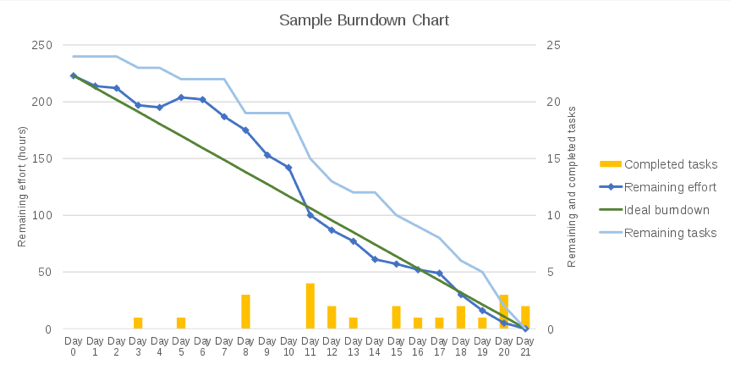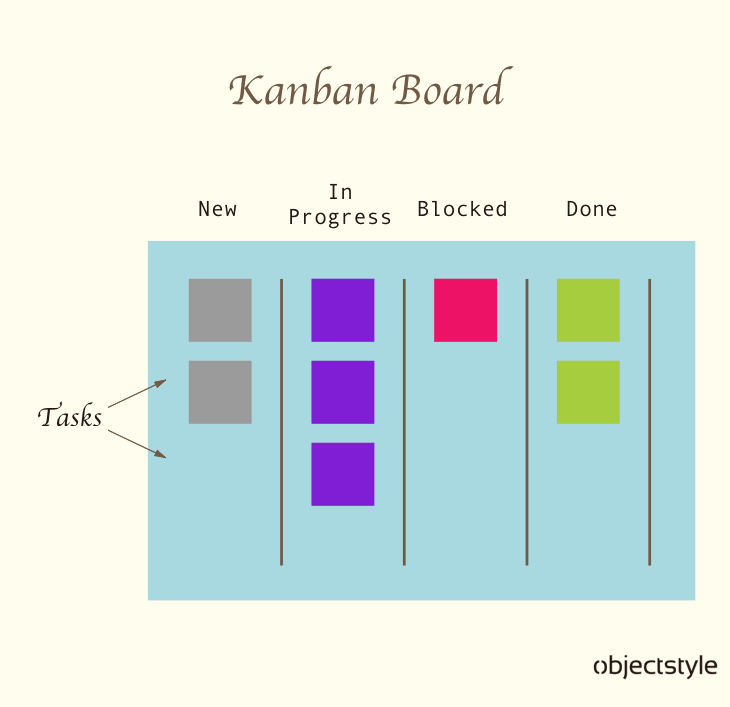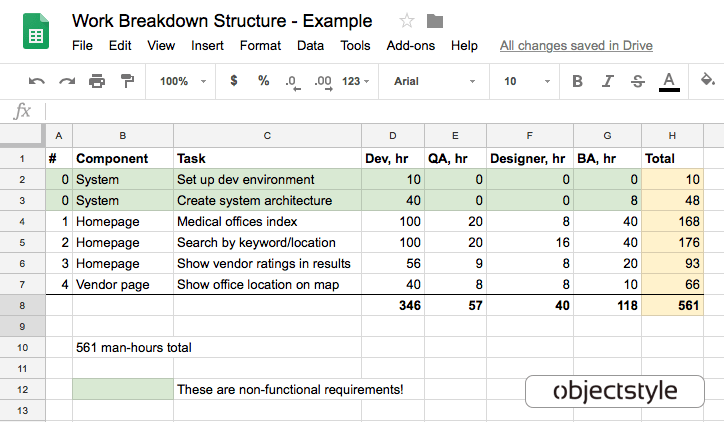Project Management Glossary: 33 Essential Terms

The reason we decided to put together this glossary is that we write a lot about software project management on ObjectStyle’s blog. We hope it will be useful to anyone reading about project management and/or struggling to understand the PM jargon.
Anywhere in this article, “PM” stands for “project management.” If a term is in italics (for example – Scrum), this means it’s defined in a respective place in the glossary.
A
Agile
An iterative approach to development where the team delivers bits of software in frequent, rapid cycles. It’s not a concrete method, but rather a set of principles described in the Agile Manifesto in 2001.
Agile Release Train (ART)
While the term may sound confusing, what it really means is “a team of teams.” ARTs are used in the SAFe framework where groups of teams stick together over a long period of time to deliver work at the Program level.
B
Backlog
An unordered list of to-do items for the projects. The backlog provides a pool of tasks out of which you pick work items for the nearest Sprint during the Sprint planning event.
Burndown Chart
A diagram that shows work left to do versus time. It has the “Ideal burndown,” aka “Ideal remaining work” line, against which you can measure actual progress.

D
Daily Scrum
A daily meeting practiced in the Scrum project management framework. At this meeting, each person on the Scrum team briefly answers three questions: “What did you do yesterday?” “What will you do today?” and “Are there any obstacles?”
Definition of Done (DoD)
A concise list of criteria a feature must meet to be ticked off as done. This often includes the activities that must be completed for a piece of functionality to be marked as “potentially shippable.”
E
Extreme Programming (XP)
A set of programming practices – TDD, pair programming, continuous integration, collective code ownership, etc. – popularised by Kent Beck. XP takes certain programming techniques to an extreme to maximize their effectiveness.
F
Framework
A process template according to which a project is run. A framework prescribes project stages, organization units, sequence of actions, practices, etc. Popular PM frameworks include Scrum, Kanban, Extreme Programming (XP), and others.
Functional analysis
A method of estimating a software project. In functional analysis, the project is broken into features, and each feature is assigned a particular number of functional points to indicate its difficulty.
K
Kanban
An Agile framework used in software project management. In Japanese, “kanban” means “visible board/poster.” The framework places importance on visualizing the workflow, making everyone’s work transparent, and disseminating information, among other things.

L
Lean
An approach to software development popularized by Mary and Tom Poppendieck in their book Lean Software Development. It propagates starting small, releasing a Minimum Viable Product (MVP) as early as possible, and adding features to it as you go.
P
Portfolio
The highest management level in Scaled Agile Framework (SAFe). At the portfolio level, you get a birds-eye view of all projects in an organization. That is where you manage the people and practices needed for the completion your strategic business goals. Lower organizational levels are Program (smaller than Portfolio) and Team (smaller than Program).
PRINCE2
Stands for PRojects IN Controlled Environments, version two. Is a project management method initially developed as a UK Government standard for managing information systems projects. PRINCE2 divides a project into controllable stages and provides guidance (and doc templates) on how each process should be managed. The method is generally used for high-level management and can be combined with other Agile frameworks like Scrum.
Product Increment
A piece of functionality or a product feature delivered at the end of an Agile cycle. Usually, it’s a deliverable shipped at the end of each sprint in Scrum.
Product Owner
A person who has a holistic view of the product. A Product Owner focuses on product features as they’re perceived by the end user, while a Project Manager is more concerned with the technical implementations of those features.
Product Sponsor
A member of the C-Suite (a senior exec) who communicates strategic goals to the Agile team. This is done to ensure the development team stays informed about the latest business status of the project. Not a full-time job.
Project Management Office
A department responsible for storing and disseminating project management expertise in an organization. It is a source of valuable PM knowledge, documentation, standards, KPIs, and other helpful information.
Project Manager
A person who manages the team and serves as an intermediary between the team and the client/stakeholders. The PM plans and oversees project execution while also communicating with the party sponsoring the project on a regular basis.
R
Retrospective
A meeting held at the end of each Sprint in the Scrum framework. During a Sprint retrospective organized by the Scrum Master, participants discuss the Sprint in an open, no-blame-placed conversation. The purpose is to learn from experience and to improve continuously.
S
Scaled Agile
Traditional Agile approach, adjusted to suit a large organization. In scaled Agile frameworks, one finds larger organizational units (for instance, “a team of teams”) and additional practices that help manage a bigger crowd of people and a more complex set of dependencies.
SAFe (Scaled Agile Framework)
One of the most popular Scaled Agile frameworks. SAFe provides guidance as to how to plan and organize work at the Portfolio, Program, and Team level.
Scope Creep
A project’s work scope is described in the Vision and Scope document. When unexpected changes are made to the scope, this can lead to “scope creep” and eventually delay the project.
Scrum
By far the most popular and widely used Agile framework. In Scrum, work is done in short iterations known as Sprints. The Scrum team is cross-functional and self-organizing (where no one is the boss), and the Scrum Master simply serves to facilitate the framework’s implementation.
Scrum Master
A person whose job is to ensure the team follows Scrum. The Scrum Master should also remove any impediments that hamper the Scrum process (a lack of information, unresolved dependencies, etc.).
Scrum Team
A cross-functional team of usually up to 9 people. May consist of a business analyst, a designer, a developer, a Scrum Master, a QA, etc. Scrum teams are normally self-organizing; that is, nobody is telling anyone what to do.
Six Sigma
A statistical analysis-based method of plotting defects to identify development process weaknesses and areas that can be optimized.
Sprint
A two-week work period during which the team works to deliver a product increment in Scrum. Is preceded by a planning event and is followed by a retrospective meeting.
T
Test-Driven Development (TDD)
An Extreme Programming practice. Before turning a software requirement into code, a programmer writes an automated test for it first. This is done to increase testability and maintainability of the code written.
Time and Material
A concept used to estimate software project costs. In a time-and-material contract, one pays contractors by the hour (or another time period) and may compensate additional costs.
U
User Story
A way of writing a requirement to the product. It’s written in the following format: “As a [Role], I want the software to [do this and this], so that [this and this result is achieved].” For example: “As a blogger, I want to be able to schedule a blog post so that it is published at some point in the future.”
V
Vision and Scope
The Vision and Scope document is normally created early in the development cycle. It describes product vision, economical justification, users, stakeholders, features, the scope of work required to implement initial features, and related information.
W
Waterfall
The traditional Waterfall methodology consists in careful planning, stage-based approach and delivering the full product at the finish line. A Waterfall project goes through gradual (not concurrent) stages, such as planning, development, testing, and launch to production.
Work Breakdown Structure (WBS)
A document that contains a structured list of program components (at the highest level) and major/minor features, as well as their descriptions and effort estimates. A WBS document is filled out by different people assigned to a project (a BA, a developer, a QA) and each enters the amount of effort required for each listed feature.

Related Blogs

What are user stories, and who should write them?
LEARN MORE